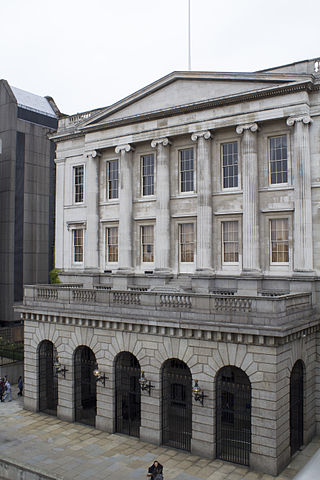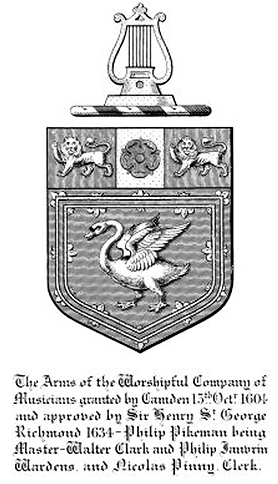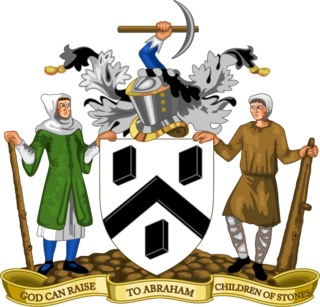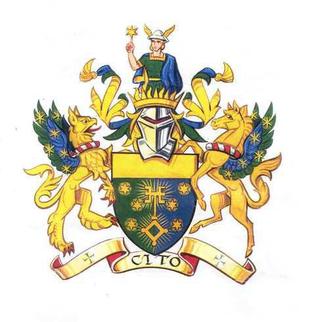
There are 111 livery companies, comprising London's ancient and modern trade associations and guilds, almost all of which are styled the "Worshipful Company of" their respective craft, trade or profession. These livery companies play a significant part in the life of the City, not least by providing charitable-giving and networking opportunities. Liverymen retain voting rights for the senior civic offices, such as the Lord Mayor, Sheriffs and Common Council of the City Corporation, London's ancient municipal authority with extensive local government powers.
The Worshipful Company of Scriveners is one of the 111 livery companies of the City of London. The Scriveners Company was originally known as the Mysterie of the Writers of the Court Letter and, since its incorporation, as Master Wardens and Assistants of the Company of Scrivenors of the Cittie of London [sic]. It is one of the few livery companies that from its foundation to the present day has been influential in setting the standards for a living profession, namely that of scrivener notary. The company's first ordinances were granted in 1373. Its royal charter was granted by King James I on 28 January 1617.

The Worshipful Company of Vintners is one of the oldest Livery Companies of the City of London, England, thought to date back to the 12th century. It is one of the "Great Twelve" livery companies of London, and its motto is Vinum Exhilarat Animum, Latin for "Wine Cheers the Spirit". One of the more peculiar rights of the Company involves the ceremony of swan upping.

The Worshipful Company of Cutlers is one of the ancient Livery Companies of the City of London. It ranks 18th in the order of precedence of the Companies.

The Worshipful Company of Armourers and Brasiers is one of the livery companies of the City of London. The Armourers' Guild was established in 1322; it received a royal charter in 1453. Other companies, including the Armour Repairers, merged with the Armourers. In 1708, brass workers joined the company, which was renamed as the Armourers' and Brasiers' Company. The company does support the metallurgy industry, but does not retain a close association with its original trade, as is the case with a majority of livery companies. It exists primarily as a charitable establishment.

The Worshipful Company of Carpenters is a livery company of the City of London. The Carpenters were traditionally different from a fellow wood-crafting company, the Worshipful Company of Joiners and Ceilers, in that carpenters utilised nails while joiners used adhesives to attach wood.

The Worshipful Company of Painter-Stainers is one of the livery companies of the City of London. An organisation of painters of metals and wood is known to have existed as early as 1283. A similar organisation of stainers, who generally worked on staining cloth for decorative wall hangings, existed as early as 1400. The two bodies merged in 1502; the new organisation was incorporated under a Royal Charter in 1581.

The Worshipful Company of Musicians is one of the Livery Companies of the City of London. Its history dates back to at least 1350. Originally a specialist guild for musicians, its role became an anachronism in the 18th century, when the centre of music making in London moved from the City to the West End, and for more than a century it was a general guild for figures in the City, with no specific musical role. In the late 19th century, the musical element was revived, and the modern Company promotes all aspects of the art and science of music.

The Worshipful Company of Paviors is one of the livery companies of the City of London. The Paviors can trace their history back to medieval times; they were responsible for the paving and maintenance of London's streets. It received a royal charter from Queen Elizabeth II in 2004. The company is no longer a trade association for or a regulator of London's road constructors. Today, it focuses on the promotion of excellence in all areas of construction.
The Worshipful Company of Framework Knitters is one of the Livery Companies of the City of London. It was incorporated by Oliver Cromwell in 1657, with a Royal Charter from Charles II in 1663. It was granted livery status in 1713. For a period it had its own hall in Red Cross Street, however for various reasons it was sold.

The Worshipful Company of Carmen is one of the Livery Companies of the City of London, whose origins date back to 1517.
The Worshipful Company of Tobacco Pipe Makers and Tobacco Blenders is one of the Livery Companies of the City of London. The Company ranks 82nd in the order of precedence of the Companies. It does not have its own livery hall but meets instead at various halls of other Livery Companies.
The Worshipful Company of Actuaries is one of the livery companies of the City of London. The company was founded and became a livery company in 1979, on the same day as the Insurers' Company. The company supports the actuarial profession by awarding scholarships in the field.
Distillers' Company may mean:
The Worshipful Company of Hackney Carriage Drivers is one of the 111 livery companies of the City of London. Its members are professional hackney carriage drivers, including London black taxicab drivers who have learnt the knowledge of London.

The Worshipful Company of Firefighters is one of the 110 livery companies of the City of London. The Company's aim is to promote the development and advancement of the science, art and the practice of firefighting, fire prevention and life safety. It operates essentially as a charitable organisation, and also encourages professionalism and the exchange of information between members and others who work in allied fields.

Sir Théodore Turquet de Mayerne was a Genevan-born physician who treated kings of France and England and advanced the theories of Paracelsus.

The Worshipful Company of Educators is the 109th livery company of the City of London, having been granted livery status on 10 September 2013 by the Court of Aldermen. The Company was founded on 24 May 2001 as a Guild to represent the education and training profession and for charitable purposes. On 15 September 2009 the City's Court of Aldermen granted the petition of the Guild of Educators and agreed that the Guild be constituted one of the Companies of the City, without a grant of livery, with the title of The Company of Educators and that its Ordinances be approved and duly enrolled amongst the records of the City. Upon being advanced to the status of City livery company in 2013, the Company was accorded the official title of Worshipful Company of Educators, although less formally it can continue to be known as the Educators' Company.
Sir Thomas Cademan (1590?–1651) was an English recusant physician.














